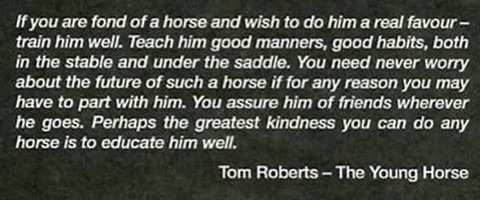It is not just “backyard” situations, but also some reputable breeders. The situation I am describing was 30 years ago, but I am sure the same thing applies today.
The farm was breeding Thoroughbreds for the race track (where many were successful), and also sold quite a few for sport. (Do you remember JJ Babu? He came from this farm.) The farm was in the business of breeding and selling young stock, not training. So any horses that did not sell as yearlings stayed on the farm to be sold as 2 year olds, and so on. After they didn’t sell as 3 year olds, the mares were turned out in big fields (with supplemental hay and grain put out as needed, and some kind of wormer mixed in with the feed once a year). They were not handled.
The colts (kept entire, because that is what the racing market preferred) were kept in a barn, and turned out daily in individual paddocks. So they were handled, but received no additional training.
Eventually, when he was in his mid 80s, the owner was convinced to stop breeding, and, when he turned 90, the non-breeding stallions were gelded, and they were all put up for sale - 30 or more horses aged 6 and up with little to no handling. The price for each mare was $1000, and the price for each gelding was $2000. (This was backwards - with the mares, even if they were not trainable they still had value as broodmares because of the excellent bloodlines.)
After (I think) 3 months, they had an auction, on the farm, of all the remaining stock. I think that all but one sold for under $1000.
My sister bought one of the mares (during the “each mare for $1000” phase), who was clearly the boss-mare of her herd. We were told that she had been “sold” 3 times before, but each time they could not catch her, and the buyer bought a different one… This time it took them several days for them to catch her and get her into a barn. Our vet could only observe her in the stall, and then watch her after they let her loose, and she took off back to her herd. It took two separate trips to get her loaded into the trailer and bring her home.
The first year was a real battle of wills, but my sister is both stubborn and brave (as well as being a good rider) and they were successfully competing in Prelim Eventing a couple of years later.
But I doubt that most of them had such a positive outcome.
About a year later I got a plaintive call from the young lady who had been helping look after the horses. One of the geldings (who happened to be full brother to my sister’s horse), now 10, had been bought by a local man, who had given him some basic ground work, but when he tried to back him, the horse refused to move. (Also he was lame because he had lost a shoe and “missed” the farrier appointment.) Unless someone bought him before “this weekend” he was going to the Thurmont suction, (unsound and unrideable, there was only one likely outcome).
I went to look at him on Wednesday, decided he had an agreeable temperament, and the lameness did look like just foot-soreness. and brought him home (for $300) on Friday. I had him vetted AFTER I got home, and found some hip arthritis, but it would not have made any difference.
Unlike his sister, he was very anxious to please, and I restarted him with no problem. If he was scared, he would plant his feet and refuse to move. (unlike his sister, who would either bolt or attack). But if he was calm, he was perfectly willing to go forward. I intended to train him and resell him, but that didn’t happen (in part because of the arthritis, but also because there is not much of a market for green teenaged horses). But I was able to lease him out, and he took 2 young girls from “just starting to jump” to competing at Beginner Novice and Novice. (His hip arthritis started bothering him too much above that height). In his older days he was ridden about once a month by a 6 year old girl. He lived to be 36.
Anyway, my point is that even breeding operations that really ARE reputable may produce a lot of mature horse with no training and no, or little, handling.




 . They had no clue what to do. Couldn’t catch the horse, thought it might’ve injured itself but didn’t know how to assess, and frankly seemed scared of it. I deployed my patented maneuver: “Don’t mind me, loose horse. I’m just going to stand here and ignore you. Why are you coming up to me, loose horse? I’m trying to mind my own business!” (Usually ends with the horse shoving it’s nose under my arm
. They had no clue what to do. Couldn’t catch the horse, thought it might’ve injured itself but didn’t know how to assess, and frankly seemed scared of it. I deployed my patented maneuver: “Don’t mind me, loose horse. I’m just going to stand here and ignore you. Why are you coming up to me, loose horse? I’m trying to mind my own business!” (Usually ends with the horse shoving it’s nose under my arm  ) .
) .